Spatial Estimation of Soil Loss and Planning of Suitable Soil and Water Conservation Interventions for Environmental Sustainability in Northern Karnataka in India Using Geospatial Techniques
Abstract
1. Introduction
2. Materials and Methods
2.1. Study Area
2.2. Soil Erosion Estimation Using Revised Universal Soil Loss Equation (RUSLE)
2.3. Prioritization of Vulnerable Areas
2.4. Determination of Location-Specific Interventions
| Interventions | Slope (%) | Soil Type | Rainfall (mm) | Soil Depth (cm) |
|---|---|---|---|---|
| Ridge and furrow | 2–15 (b) | Loamy/loamy skeletal | >350 (c) and <1000 | >50 (field crops) |
| Semi circular bunds | 5–15 (b) | exclude sandy soil (b) | >200 and <4000 (b) | 100–150 (b) (tree crops) |
| Small pits | 2–10 (b) | exclude sandy soil (b) | >350 and <4000 | >50 (b) (shrubs) >10 0 (b) (tree crops) |
| Broad Bed Furrow (BBF) | ≤3 (e) | clayey and loamy soil | >750 | 100–150 (field crops) |
| Compartmental bunding | ≤1 (e) | clayey soil (e) | >400 and < 750 | >50 (e) (field crops) |
| Conservation furrow | ≤10 (c) | exclude sandy soil (b) | ≤1500 | <100 (field crops) |
| Contour/graded bunds | 1–6 (a) | exclude deep clayey soil (a) | >200 and <600 (c) | <100 (c) (field and tree crops) |
| Contour cultivation | ≤5 (d) | exclude sandy soil | >350 and <4000 | >100 (d) (field and tree crops) |
3. Results
3.1. Rainfall, Erosivity, and Soil Loss in Northern Dry Zone of Karnataka
3.2. Variability in Rainfall, Erosivity, and Soil Loss in Different Rainfall Regions
3.3. Prioritization of Vulnerable Areas
3.4. Suitable Locations for In Situ Moisture Conservation Measures and Water-Harvesting Structures
4. Discussion
4.1. Soil Loss Estimation Using RUSLE
4.2. Planning Site-Specific Soil and Water Conservation Interventions
5. Conclusions
Author Contributions
Funding
Data Availability Statement
Acknowledgments
Conflicts of Interest
References
- Pimentel, D.; Kounang, N. Ecology of soil erosion in ecosystems. Ecosystems 1998, 1, 416–426. [Google Scholar] [CrossRef]
- Borrelli, P.; Alewell, C.; Alvarez, P.; Anache, J.A.A.; Baartman, J.; Ballabio, C.; Bezak, N.; Biddoccu, M.; Cerdà, A.; Chalise, D.; et al. Soil erosion modelling: A global review and statistical analysis. Sci. Total Environ. 2021, 780, 146494. [Google Scholar] [CrossRef] [PubMed]
- Rickson, R.J.; Deeks, L.K.; Graves, A.; Harris, J.A.; Kibblewhite, M.G.; Sakrabani, R. Input constraints to food production: The impact of soil degradation. Food Secur. 2015, 7, 351–364. [Google Scholar] [CrossRef]
- Stefanidis, S.; Alexandridis, V.; Ghosal, K. Assessment of Water-Induced Soil Erosion as a Threat to Natura 2000 Protected Areas in Crete Island, Greece. Sustainability 2022, 14, 2738. [Google Scholar] [CrossRef]
- Köninger, J.; Panagos, P.; Jones, A.; Briones, M.J.I.; Orgiazzi, A. In defence of soil biodiversity: Towards an inclusive protection in the European Union. Biol. Conserv. 2022, 268, 109475. [Google Scholar] [CrossRef]
- Prasannakumar, V.; Shiny, R.; Geetha, N.; Vijith, H.J. Spatial prediction of soil erosion risk by remote sensing, GIS and RUSLE approach: A case study of Siruvani river watershed in Attapady valley, Kerala, India. Environ. Earth Sci. 2011, 64, 965–972. [Google Scholar] [CrossRef]
- Eswaran, H.; Lal, R.; Reich, P.F. Land degradation: An overview. In Response to Land Degradation; CRC Press: Boca Raton, FL, USA, 2019; pp. 20–35. [Google Scholar]
- Salifu, E.; Agyare, W.A.; Kyei-Baffour, N.; Dumedah, G. Estimation of Soil Erosion in Three Northern Regions of Ghana Using RUSLE in GIS Environment. Int. J. Appl. Geospat. Res. 2021, 12, 1–19. [Google Scholar] [CrossRef]
- Wynants, M.; Patrick, A.; Munishi, L.; Mtei, K.; Bodé, S.; Taylor, A.; Millward, G.; Roberts, N.; Gilvear, D.; Ndakidemi, P.; et al. Soil erosion and sediment transport in Tanzania: Part II—Sedimentological evidence of phased land degradation. Earth Surf. Process. Landf. 2021, 46, 3096–3111. [Google Scholar] [CrossRef]
- Panagos, P.; Borrelli, P.; Matthews, F.; Liakos, L.; Bezak, N.; Diodato, N.; Ballabio, C. Global rainfall erosivity projections for 2050 and 2070. J. Hydrol. 2022, 610, 127865. [Google Scholar] [CrossRef]
- Jain, S.K. Water resources management in India—Challenges and the way forward. Curr. Sci. 2019, 117, 00113891. [Google Scholar] [CrossRef]
- Singh, V.K.; Prasad, J.V.N.S.; Osman, M.; Ramana, D.B.V.; Nagasree, K.; Rejani, R.; Subbarao, A.V.M.; Srinivas, I.; Prabhakar, M.; Singh, L.; et al. Promising Climate Resilient Technologies for Maharashtra; ICAR—Central Research Institute for Dry Land Agriculture: Hyderabad, India, 2021; 105p. [Google Scholar]
- Vanwalleghem, T.; Gómez, J.A.; Amate, J.I.; de Molina, M.G.; Vanderlinden, K.; Guzmán, G.; Laguna, A.; Giráldez, J.V. Impact of historical land use and soil management change on soil erosion and agricultural sustainability during the Anthropocene. Anthropocene 2017, 17, 13–29. [Google Scholar] [CrossRef]
- Vente, J.D.; Poesen, J. Predicting soil erosion and sediment yield at the basin scale: Scale issues and semi-quantitative models. Earth Sci. Rev. 2005, 71, 95–125. [Google Scholar] [CrossRef]
- Tsufac, A.R.; Awazi, N.P.; Yerima, B.P. Characterization of agroforestry systems and their effectiveness in soil fertility enhancement in the south-west region of Cameroon. Curr. Res. Environ. Sustain. 2021, 3, 100024. [Google Scholar] [CrossRef]
- El-Naggar, A.; Lee, S.S.; Rinklebe, J.; Farooq, M.; Song, H.; Sarmah, A.K.; Zimmerman, A.R.; Ahmad, M.; Shaheen, S.M.; Ok, Y.S. Biochar application to low fertility soils: A review of current status, and future prospects. Geoderma 2019, 337, 536–554. [Google Scholar] [CrossRef]
- Zheng, H.; Liu, W.; Zheng, J.; Luo, Y.; Li, R.; Wang, H.; Qi, H. Effect of long-term tillage on soil aggregates and aggregate-associated carbon in black soil of Northeast China. PLoS ONE 2018, 13, e0199523. [Google Scholar] [CrossRef] [PubMed]
- Gao, X.; Li, H.; Zhao, X.; Ma, W.; Wu, P. Identifying a suitable revegetation technique for soil restoration on water-limited and degraded land: Considering both deep soil moisture deficit and soil organic carbon sequestration. Geoderma 2019, 319, 61–69. [Google Scholar] [CrossRef]
- Thaler, E.A.; Larsen, I.J.; Yu, Q. The extent of soil loss across the US Corn Belt. Proc. Natl. Acad. Sci. USA 2021, 118, e1922375118. [Google Scholar] [CrossRef]
- Bajirao, T.S.; Kumar, P. Geospatial technology for prioritization of Koyna River basin of India based on soil erosion rates using different approaches. Environ. Sci. Pollut. Res. 2021, 28, 35242–35265. [Google Scholar] [CrossRef]
- Ahmed, B.; Sihem, J.; Lakhdar, K. Chapter Spatial Estimation of Soil Erosion Risk Using RUSLE/GIS Techniques and Practices Conservation Suggested for Reducing Soil Erosion in Wadi Mina Catchment (Northwest, Algeria). 2021. Available online: https://library.oapen.org/handle/20.500.12657/49388 (accessed on 20 January 2022).
- Ramkumar, M.; Kumaraswamy, K.; James, R.A.; Suresh, M.; Sugantha, T.; Jayaraj, L.; Mathiyalagan, A.; Saraswathi, M.; Shyamala, J. Sand mining, channel bar dynamics and sediment textural properties of the Kaveri River, South India: Implications on flooding hazard and sustainability of the natural fluvial system. In Environmental Management of River Basin Ecosystems; Springer: Cham, Switzerland, 2015; pp. 283–318. [Google Scholar]
- Shojaei, S.; Kalantari, Z.; Rodrigo-Comino, J. Prediction of factors affecting activation of soil erosion by mathematical modeling at pedon scale under laboratory conditions. Sci. Rep. 2020, 10, 20163. [Google Scholar] [CrossRef]
- Vahabi, J.; Nikkami, D. Assessing dominant factors affecting soil erosion using a portable rainfall simulator. Int. J. Sediment. Res. 2008, 23, 376–386. [Google Scholar] [CrossRef]
- Biswas, H.; Raizada, A.; Kumar, S.; Mandal, D.; Srinivas, S.; Hegde, R.; Mishra, P.K. Soil erosion risk mapping for natural resource conservation planning in Karnataka Region, Southern India. Indian J. Soil Conserv. 2019, 47, 14–20. [Google Scholar]
- NAAS-ICAR. Degraded and Waste Lands of India: Status and Spatial Distribution; Directorate of Information and Publication of Agriculture, Indian Council of Agricultural Research: New Delhi, India, 2010; 158p. [Google Scholar]
- Shashidahra, K.K.; Reddy, B.S. Farmers perceptions and adaptation about changing climate and its variability in UKP area of Karnataka. Indian Res. J. Ext. Educ. 2012, 12, 196–201. [Google Scholar]
- Bashagaluke, J.B.; Logah, V.; Opoku, A.; Tuffour, H.O.; Sarkodie-Addo, J.; Quansah, C. Soil loss and run-off characteristics under different soil amendments and cropping systems in the semi-deciduous forest zone of Ghana. Soil Use Manag. 2019, 35, 617–629. [Google Scholar] [CrossRef]
- Borrelli, P.; Robinson, D.A.; Fleischer, L.R.; Lugato, E.; Ballabio, C.; Alewell, C.; Meusburger, K.; Modugno, S.; Schütt, B.; Ferro, V.; et al. An assessment of the global impact of 21st century land use change on soil erosion. Nat. Commun. 2017, 8, 2013. [Google Scholar] [CrossRef] [PubMed]
- Wischmeier, W.H.; Smith, D.D. Predicting Rainfall Erosion Losses: A Guide to Conservation Planning (No. 537); Department of Agriculture, Science and Education Administration: Washington, DC, USA, 1978. [Google Scholar]
- Wischmeier, W.H.; Smith, D.D. Predicting Rainfall-Erosion Losses from Cropland East of the Rocky Mountains: Guide for Selection of Practices for Soil and Water Conservation; Agricultural Research Service, US Department of Agriculture: Washington, DC, USA, 1965. [Google Scholar]
- Dabral, P.P.; Baithuri, N.; Pandey, A. Soil erosion assessment in a hilly catchment of North Eastern India using USLE, GIS and remote sensing. Water Resour. Manag. 2008, 22, 1783–1798. [Google Scholar] [CrossRef]
- Renard, K.G.; Foster, G.R.; Weesies, G.A.; McCool, D.K.; Yoder, D.C. Predicting soil erosion by water: A guide to conservation planning with the Revised Universal Soil Loss Equation (RUSLE). In Agriculture Handbook; USDA: Washington, DC, USA, 1997; Volume 703, pp. 25–28. [Google Scholar]
- Das, S.; Deb, P.; Bora, P.K.; Katre, P. Comparison of RUSLE and MMF soil loss models and evaluation of catchment scale best management practices for a mountainous watershed in India. Sustainability 2021, 13, 232. [Google Scholar] [CrossRef]
- Shen, Z.Y.; Gong, Y.W.; Li, Y.H.; Hong, Q.; Xu, L.; Liu, R.M. A comparison of WEPP and SWAT for modeling soil erosion of the Zhangjiachong Watershed in the Three Gorges Reservoir Area. Agric. Water Manag. 2019, 96, 1435–1442. [Google Scholar] [CrossRef]
- Goodrich, D.C.; Burns, I.S.; Unkrich, C.L.; Semmens, D.J.; Guertin, D.P.; Hernandez, M.; Yatheendradas, S.; Kennedy, J.R.; Levick, L.R. KINEROS2/AGWA: Model use, calibration, and validation. Trans. ASABE 2012, 55, 1561–1574. [Google Scholar] [CrossRef]
- Berberoglu, S.; Cilek, A.; Kirkby, M.; Irvine, B.; Donmez, C. Spatial and temporal evaluation of soil erosion in Turkey under climate change scenarios using the Pan-European Soil Erosion Risk Assessment (PESERA) model. Environ. Monit. Assess. 2020, 192, 491. [Google Scholar] [CrossRef]
- Iqbal, M.N.; Oweis, T.Y.; Ashraf, M.; Hussain, B.; Majid, A. Impact of land-use practices on sediment yield in the Dhrabi Watershed of Pakistan. J. Environ. Sci. Eng. 2012, 1, 406–420. [Google Scholar]
- Ahmadi, M.; Minaei, M.; Ebrahimi, O.; Nikseresht, M. Evaluation of WEPP and EPM for improved predictions of soil erosion in mountainous watersheds: A case study of Kangir River basin, Iran. Model. Earth Syst. Environ. 2020, 6, 2303–2315. [Google Scholar] [CrossRef]
- Smith, H.J. Application of empirical soil loss models in southern Africa: A review. South Afr. J. Plant Soil 1999, 16, 158–163. [Google Scholar] [CrossRef]
- Hardaha, M.K. Modeling Soil Erosion by Water in Ravine Lands: Greening for Livelihood and Environmental Security; Springer: Singapore, 2018; pp. 549–572. [Google Scholar]
- Prasannakumar, V.; Vijith, H.; Abinod, S.; Geetha, N.J. Estimation of soil erosion risk within a small mountainous sub-watershed in Kerala, India, using Revised Universal Soil Loss Equation (RUSLE) and geo-information technology. Geosci. Front. 2012, 3, 209–215. [Google Scholar] [CrossRef]
- Kinnell, P.I.A. AGNPS-UM: Applying the USLE-M within the agricultural non-point source pollution model. Environ. Model. Softw. 2000, 15, 331–341. [Google Scholar] [CrossRef]
- Ghosh, K.; De, S.K.; Bandyopadhyay, S.; Saha, S. Assessment of soil loss of the Dhalai river basin, Tripura, India using USLE. Int. J. Geosci. 2013, 4, 26505. [Google Scholar] [CrossRef]
- Chary, G.R.; Srinivasa Rao, C.H.; Gopinath, K.A.; Sikka, A.K.; Kandpal, B.; Bhaskar, S. Improved Agronomic Practices for Rainfed Crops in India; All India Coordinated Research Project for Dryland Agriculture; ICAR—Central Research Institute for Dryland Agriculture: Hyderabad, India, 2016; p. 292. [Google Scholar]
- Rejani, R.; Rao, K.V.; Osman, M.; Rao, C.S.; Reddy, K.S.; Chary, G.R.; Samuel, J. Spatial and temporal estimation of soil loss for the sustainable management of a wet semi-arid watershed cluster. Environ. Monit. Assess. 2016, 88, 143. [Google Scholar] [CrossRef]
- Lal, R.; Olson, K.R.; Norton, L.D. Evaluation of methods to study soil erosion-productivity relationships. J. Soil Water Conserv. 1994, 49, 586–590. [Google Scholar]
- Reddy, R.S.; Nalatwadmath, S.K.; Krishnan, P. Soil Erosion Andhra Pradesh. NBSS Publ. 2005, 114, 76. [Google Scholar]
- Tirkey, A.S.; Pandey, A.C.; Nathawat, M.S. Use of satellite data, GIS and RUSLE for estimation of average annual soil loss in Daltonganj watershed of Jharkhand (India). J. Remote Sens. Technol. 2013, 1, 20–30. [Google Scholar] [CrossRef]
- Van der Knijff, J.M.; Jones, R.J.A.; Montanarella, L. Soil Erosion Risk Assessment in Europe. 2000. Available online: http://eusoils.jrc.ec.europa.eu (accessed on 10 January 2015).
- Indian Meteorological Department (IMD). Frequently Asked Questions (FAQs) on Monsoon. Available online: https://mausam.imd.gov.in/imd_latest/monsoonfaq.pdf (accessed on 10 January 2022).
- Mondal, A.; Kundu, S.; Mukhopadhyay, A. Rainfall trend analysis by Mann-Kendall test: A case study of north-eastern part of Cuttack district, Orissa. Int. J. Geol. Earth Environ. Sci. 2012, 2, 70–78. [Google Scholar]
- Rejani, R.; Rao, K.V.; Osman, M.; Chary, G.R.; Reddy, K.S.; Rao, C.S. Location specific insitu soil and water conservation interventions for sustainable management of drylands. J. Agrometeorol. 2015, 17, 55–60. [Google Scholar] [CrossRef]
- Rejani, R.; Rao, K.V.; Srinivasa Rao, C.H.; Osman, M.; Sammi Reddy, K.; George, B.; Pratyusha Kranthi, G.S.; Chary, G.R.; Swamy, M.V.; Rao, P.J. Identification of potential rainwater-harvesting sites for the sustainable management of a semi-arid watershed. Irrig. Drain. 2017, 66, 227–237. [Google Scholar] [CrossRef]
- Shanwad, U.K.; Patil, V.C.; Gowda, H.H.; Dasog, G.S.; Shashidhar, K.S. Generation of water resources action plan for Medak Nala Watershed in India using Remote sensing and GIS technologies. Aust. J. Basic Appl. Sci. 2011, 5, 2209–2218. [Google Scholar]
- De Pauw, E.; Oweis, T.; Youssef, J. Integrating Expert Knowledge in GIS to Locate Biophysical Potential for Water Harvesting: Methodology and a Case Study for Syria; ICARDA: Aleppo, Syria, 2008; p. 59. [Google Scholar]
- Anschütz, J.; Kome, A.; Nederlof, M.; Neef, R.D.; Ven, T. Water Harvesting and Soil Moisture Retention. Agrodok 13; Stoas Digigrafi Printers: Wageningen, The Netherlands, 2003; p. 95. [Google Scholar]
- Kalgapurkar, A.; Mishra, P.K.; Tripathi, K.P. Applicability of RS and GIS in soil and water conservation measures. Indian J. Soil Conserv. 2012, 40, 190–196. [Google Scholar]
- TNAU. Dryland Agriculture—Soil and Water Conservation Measures. Available online: https://agritech.tnau.ac.in/agriculture/agri_majorareas_dryland_enggmeasures_bbf.html (accessed on 15 December 2021).
- Rejani, R.; Rao, K.V.; Reddy, K.S.; Usharani, B.; Chary, G.R.; Gopinath, K.A.; Patode, R.S.; Osman, M. Potential sites for different in-situ moisture conservation measures in Western Vidarbha zone of Maharashtra using geospatial techniques. Indian J. Soil Conserv. 2022, 50, 120–127. [Google Scholar]
- Singh, V.K.; Prasad, J.V.N.S.; Ramana, D.B.V.; Nagasree, K.; Rejani, R.; Venkatesh, G.; Reddy, D.V.S.; Venkatasubramanian, V.; Prabhakar, M.; Bhaskar, S.; et al. Promising Climate Resilient Technologies for Karnataka; ICAR—Central Research Institute for Dry Land Agriculture: Hyderabad, India, 2021; 87p. [Google Scholar]
- Farhan, Y.; Zregat, D.; Farhan, I. Spatial estimation of soil erosion risk using RUSLE approach, RS, and GIS techniques: A case study of Kufranja watershed, Northern Jordan. J. Water Resour. Prot. 2013, 5, 1247. [Google Scholar] [CrossRef]
- Demirci, A.; Karaburun, A. Estimation of soil erosion using RUSLE in a GIS framework: A case study in the Buyukcekmece Lake watershed, Northwest Turkey. Environ. Earth Sci. 2012, 66, 903–913. [Google Scholar] [CrossRef]
- Mohamadi, M.A.; Kavian, A. Effects of rainfall patterns on runoff and soil erosion in field plots. Int. Soil Water Conserv. Res. 2015, 3, 273–281. [Google Scholar] [CrossRef]
- Singh, V.; Nema, A.K.; Chouksey, A.; Kar, S.K.; Das, S. Spatiotemporal soil erosion assessment using RUSLE model on geospatial platform for Maharashtra state. Indian J. Soil Conserv. 2021, 49, 172–180. [Google Scholar]
- Alexakis, D.D.; Hadjimitsis, D.G.; Agapiou, A. Integrated use of remote sensing, GIS and precipitation data for the assessment of soil erosion rate in the catchment area of “Yialias” in Cyprus. Atmos. Res. 2013, 131, 108–124. [Google Scholar] [CrossRef]
- Dutta, S. Soil erosion, sediment yield and sedimentation of reservoir: A review. Model Earth Syst. Environ. 2016, 2, 123. [Google Scholar] [CrossRef]
- Abdo, H.; Salloum, J. Mapping the soil loss in Marqya basin: Syria using RUSLE model in GIS and RS techniques. Environ. Earth Sci. 2017, 76, 114. [Google Scholar] [CrossRef]
- Bai, Y.; Cui, H. An improved vegetation cover and management factor for RUSLE model in prediction of soil erosion. Environ. Sci. Pollut. Res. 2021, 28, 21132–21144. [Google Scholar] [CrossRef] [PubMed]
- Toubal, A.K.; Achite, M.; Ouillon, S.; Dehni, A. Soil erodibility mapping using the RUSLE model to prioritize erosion control in the Wadi Sahouat basin, North-West of Algeria. Environ. Monit. Assess. 2018, 190, 210. [Google Scholar] [CrossRef] [PubMed]
- Kumar, A.; Devi, M.; Deshmukh, B. Integrated remote sensing and geographic information system based RUSLE modelling for estimation of soil loss in western Himalaya. India Water Resour. Manag. 2014, 28, 3307–3317. [Google Scholar] [CrossRef]
- Kumar, S.; Kushwaha, S.P. Modelling soil erosion risk based on RUSLE-3D using GIS in a Shivalik sub-watershed. J. Earth Sys. Sci. 2013, 122, 389–398. [Google Scholar] [CrossRef]
- Blanco, H.; Lal, R. Principles of Soil Conservation and Management; Springer: Dordrecht, The Netherlands, 2010; ISBN 978-1-4020-8708-0. [Google Scholar] [CrossRef]
- Moisa, M.B.; Dejene, I.N.; Merga, B.B.; Gemeda, D.O. Soil loss estimation and prioritization using geographic information systems and the RUSLE model: A case study of the Anger River Sub-basin, Western Ethiopia. J. Water Clim. Change 2022, 433, 1170–1184. [Google Scholar] [CrossRef]
- Wang, F.; Jiang, Z.R.; Li, X.J. Application of veliveria zizanioides to soil and water conservation in Shenzhen. Res. Soil Water Conserv. 2006, 1, 142–143. [Google Scholar]
- Milkias, A.; Tadesse, T.; Zeleke, H. Evaluating the effects of in-situ rainwater harvesting techniques on soil moisture conservation and grain yield of maize (Zea mays L.) in Fedis district, Eastern Hararghe, Ethiopia. Turk. J. Agric. Food Sci. Technol. 2018, 6, 1129–1133. [Google Scholar] [CrossRef]
- Qin, A.; Fang, Y.; Ning, D.; Liu, Z.; Zhao, B.; Xiao, J.; Duan, A.; Yong, B. Incorporation of manure into ridge and furrow planting system boosts yields of maize by optimizing soil moisture and improving photosynthesis. Agronomy 2019, 9, 865. [Google Scholar] [CrossRef]
- Ramakrishnan, D.; Durga Rao, K.H.; Tiwari, K.C. Delineation of potential sites for water harvesting structures through remote sensing and GIS techniques: A case study of Kali watershed, Gujarat, India. Geocarto Int. 2008, 23, 95–108. [Google Scholar] [CrossRef]
- Ramakrishnan, D.; Bandyopadhyay, A.; Kusuma, K.N. SCS-CN and GIS-based approach for identifying potential water harvesting sites in the Kali Watershed, Mahi River Basin, India. J. Earth Syst. Sci. 2009, 118, 355–368. [Google Scholar] [CrossRef]
- Raghavan, R.; Rao, K.V.; Shirahatti, M.S.; Srinivas, D.K.; Reddy, K.S.; Chary, G.R.; Gopinath, K.A.; Osman, M.; Prabhakar, M.; Singh, V.K. Assessment of Spatial and Temporal Variations in Runoff Potential under Changing Climatic Scenarios in Northern Part of Karnataka in India Using Geospatial Techniques. Sustainability 2022, 14, 3969. [Google Scholar] [CrossRef]
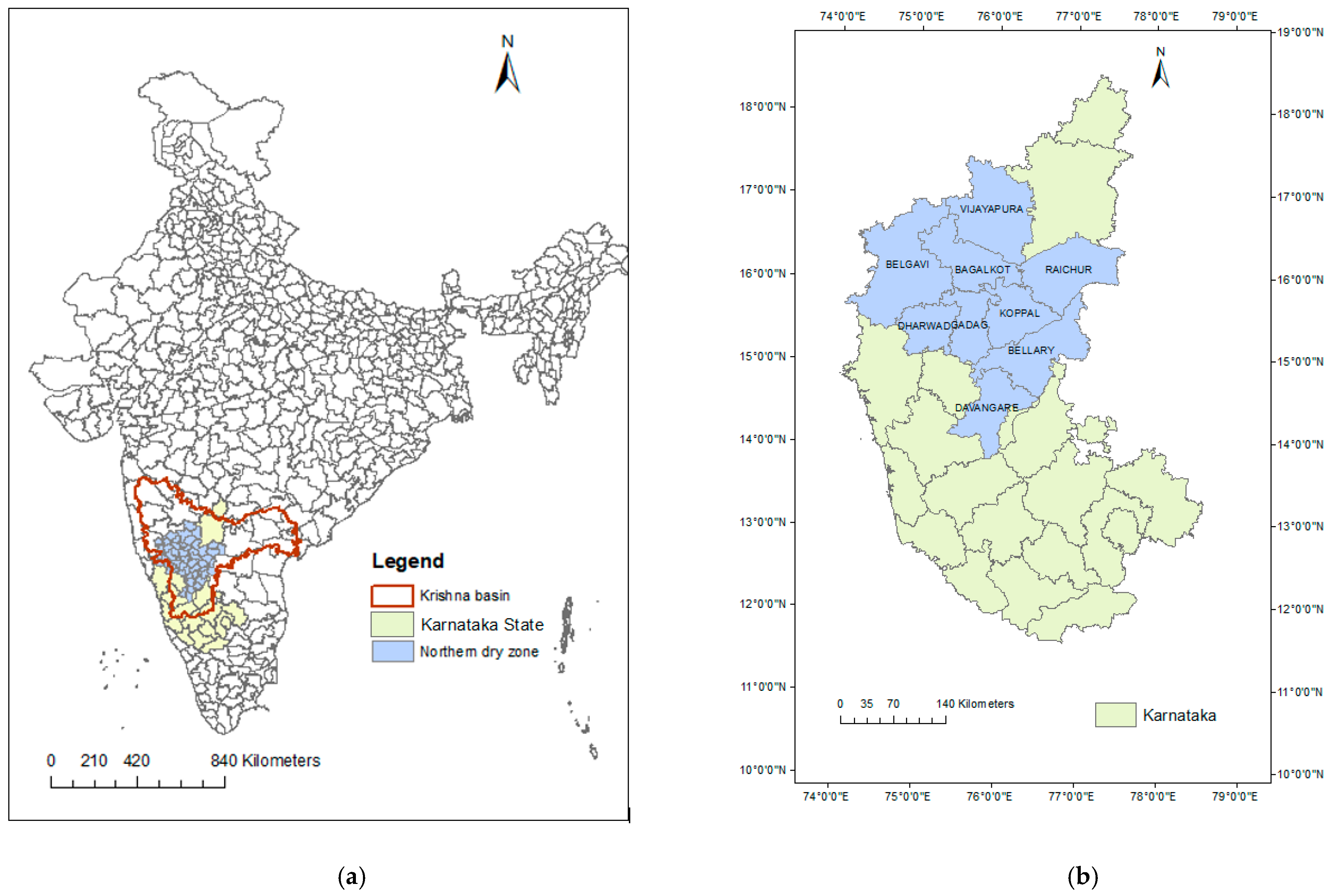
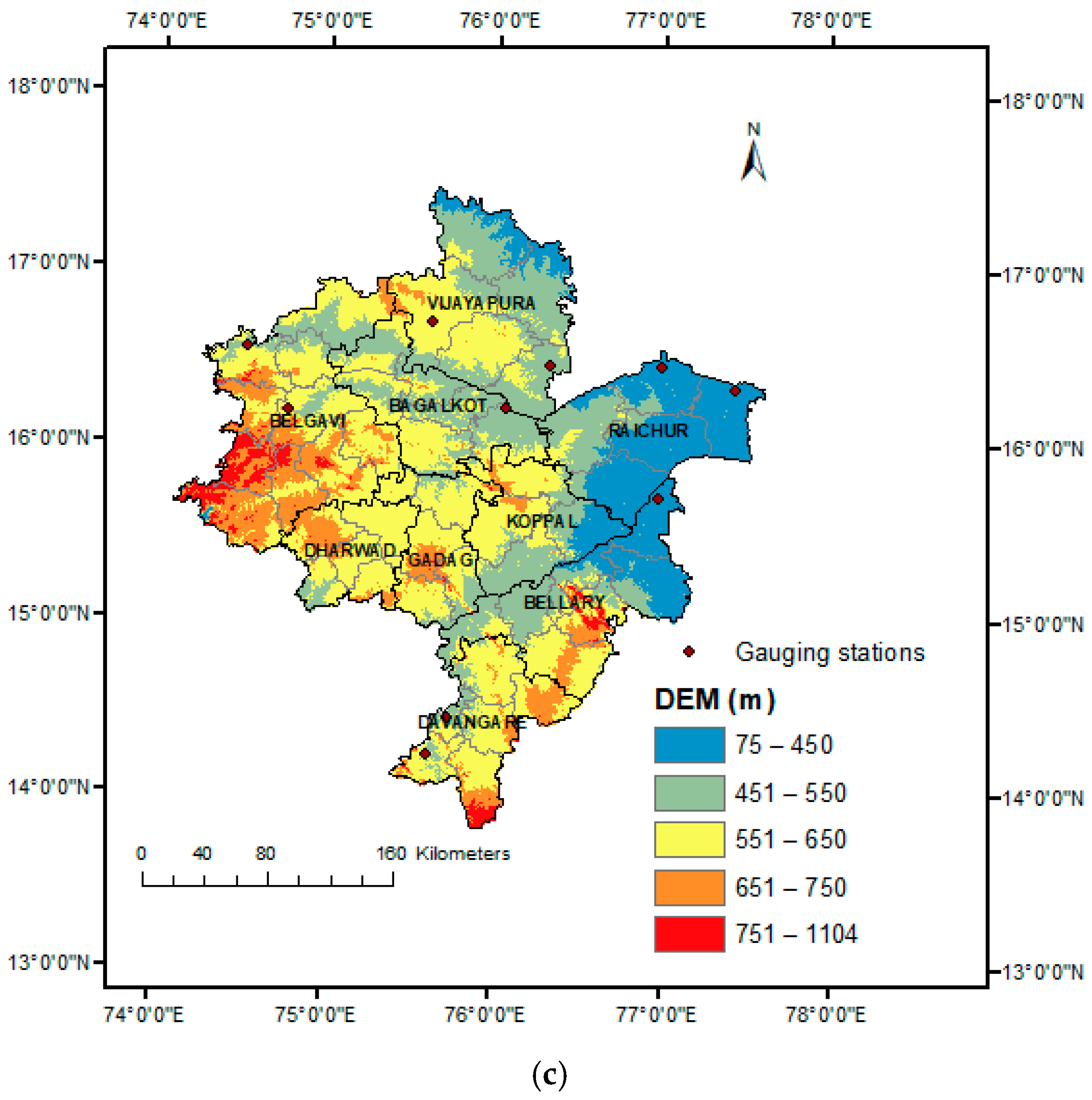
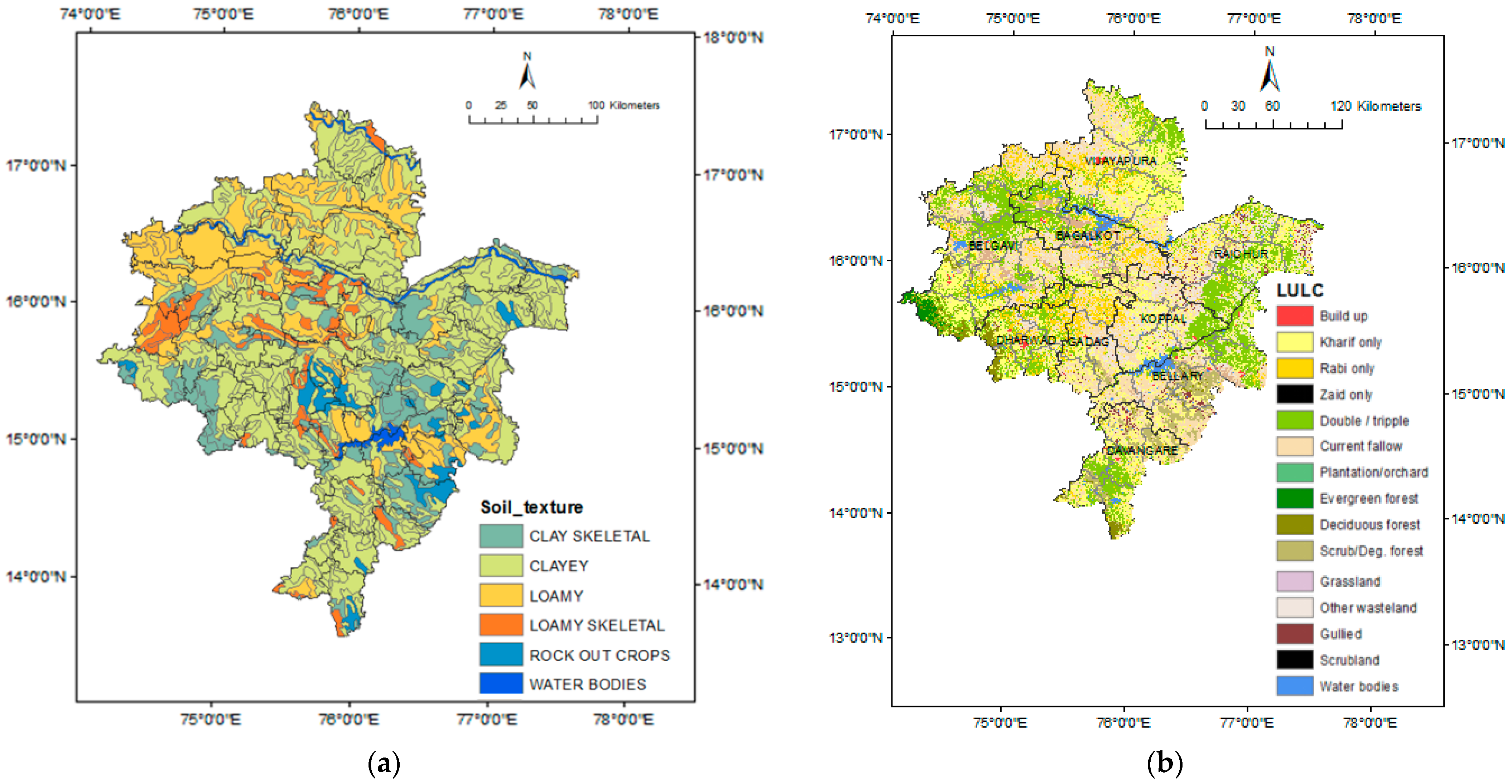
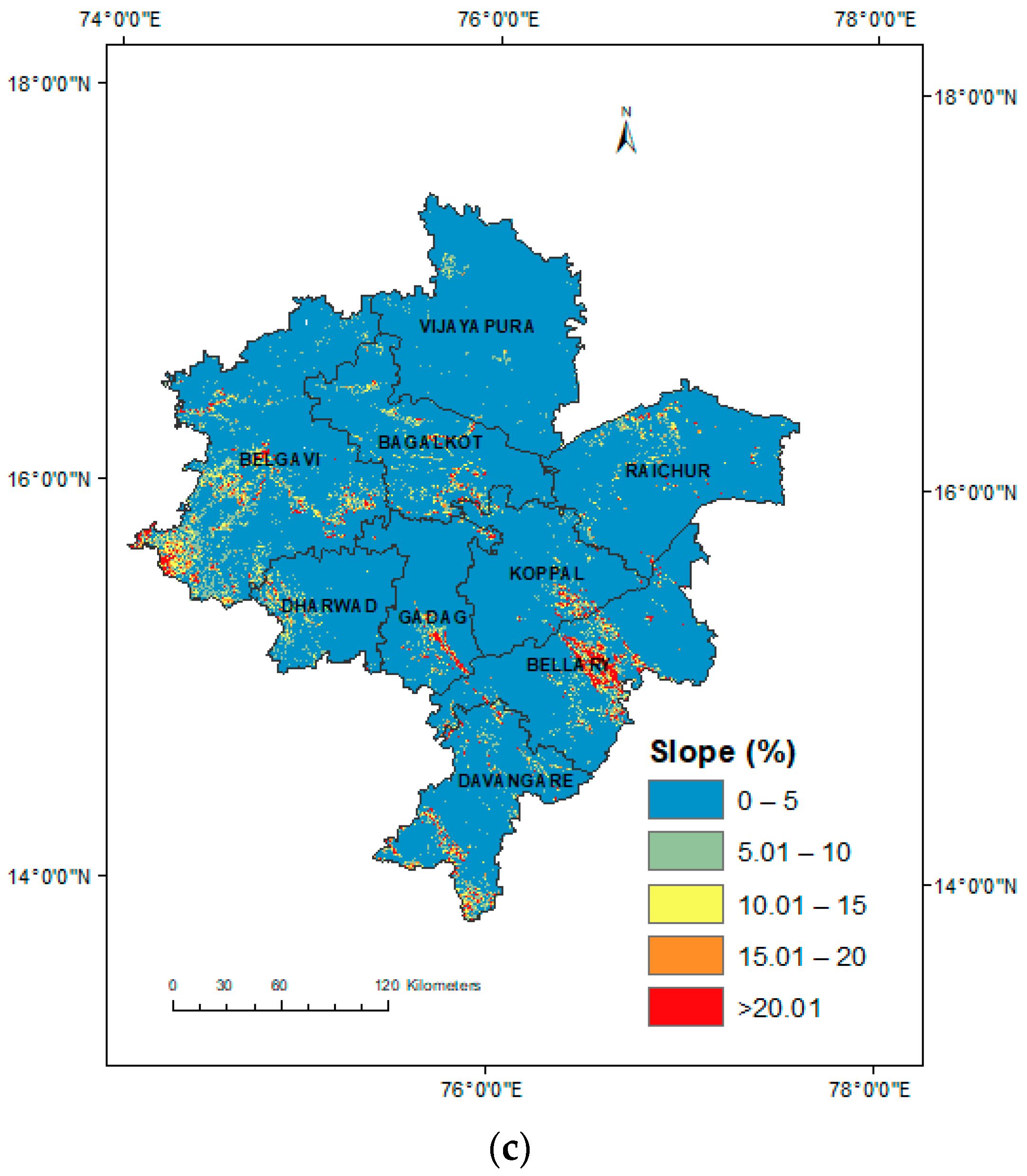
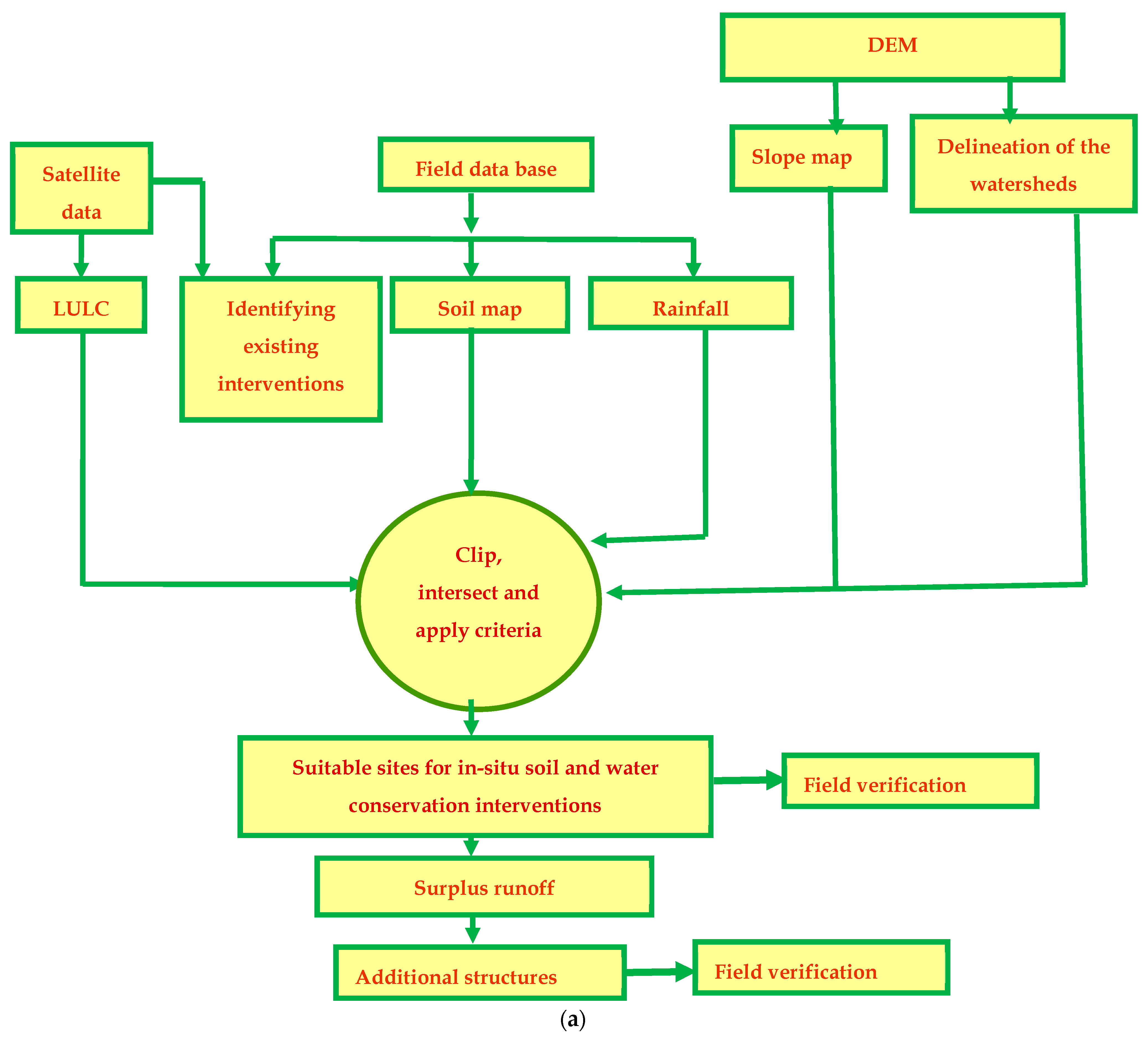
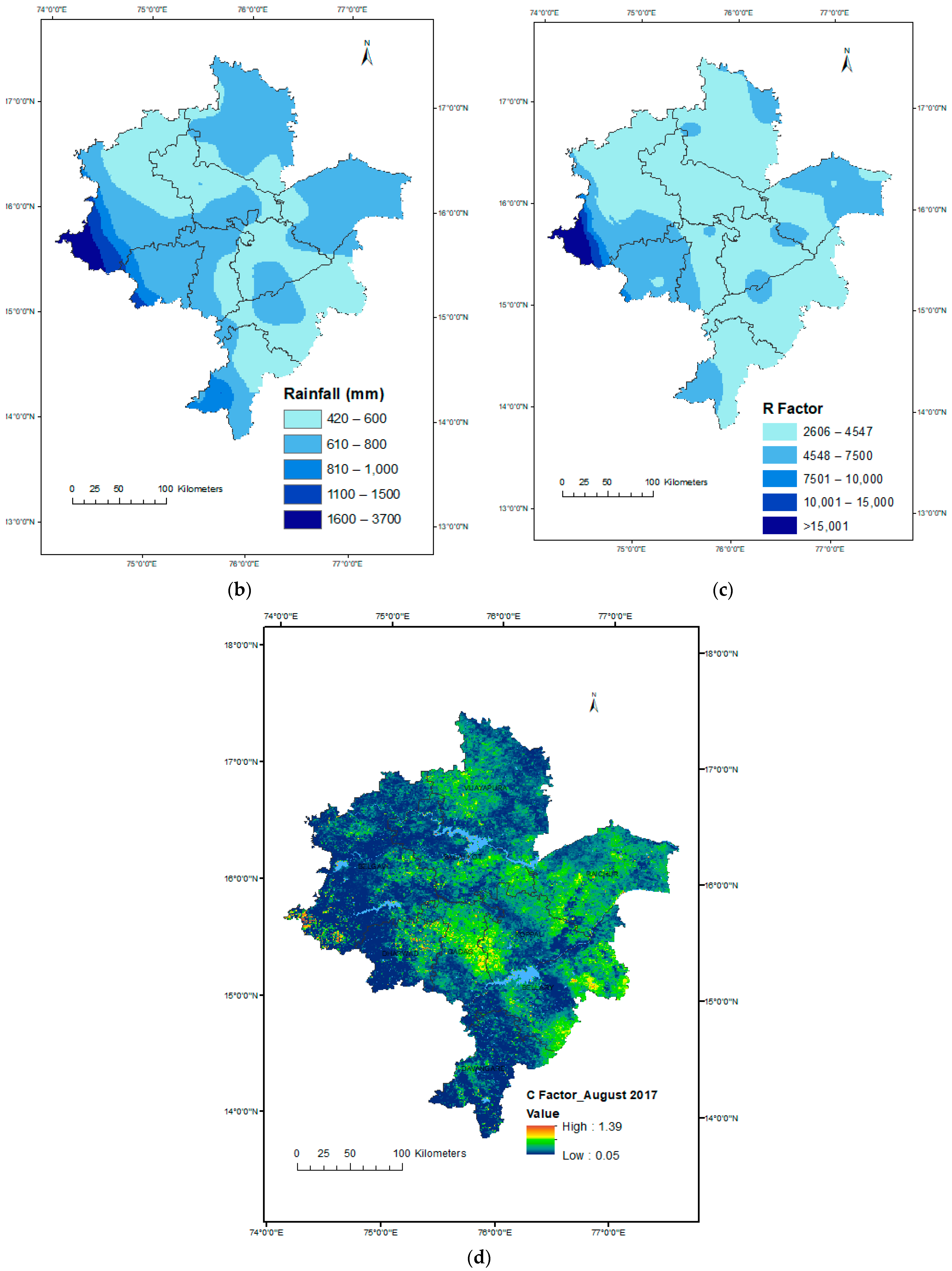
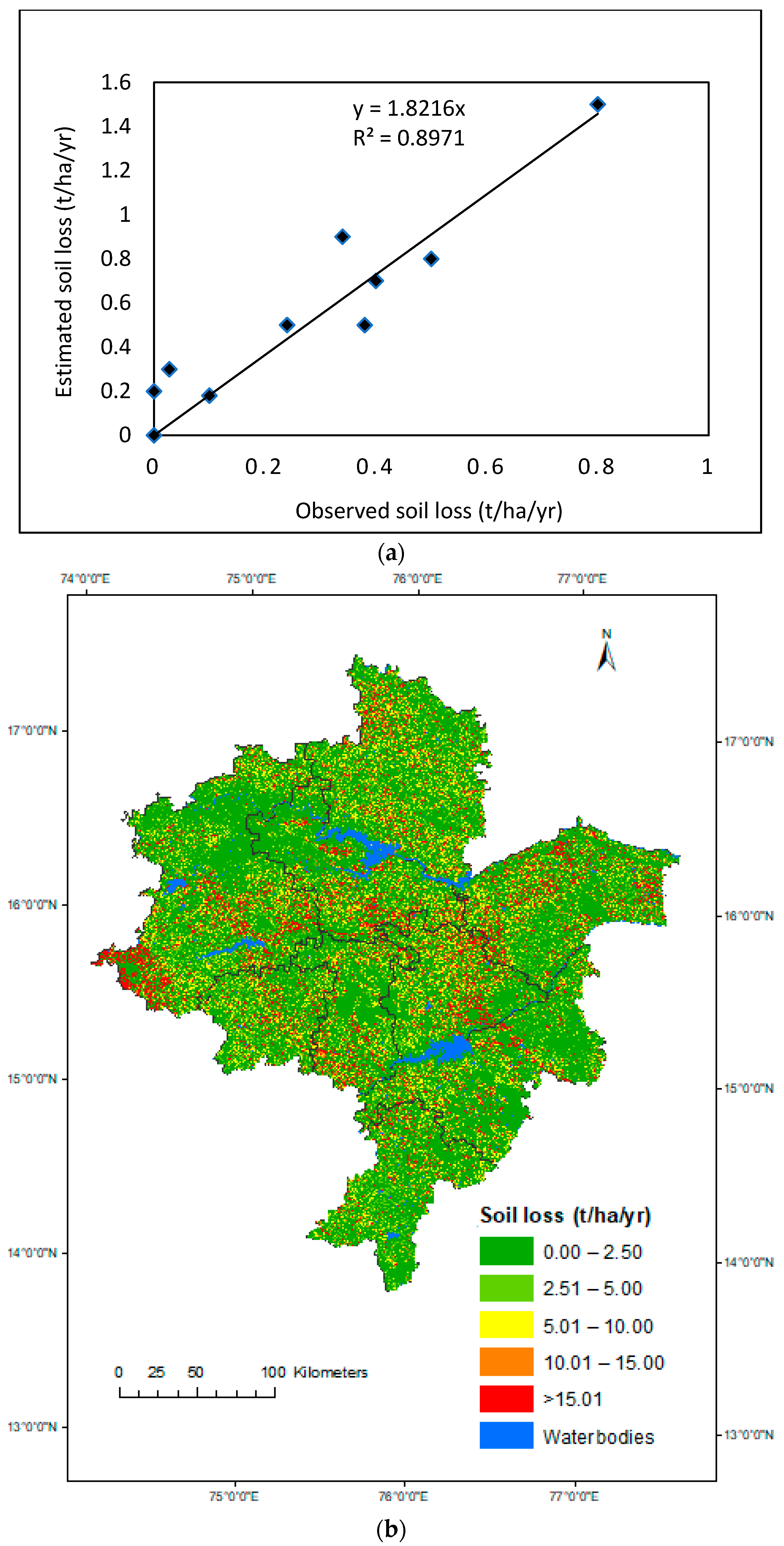
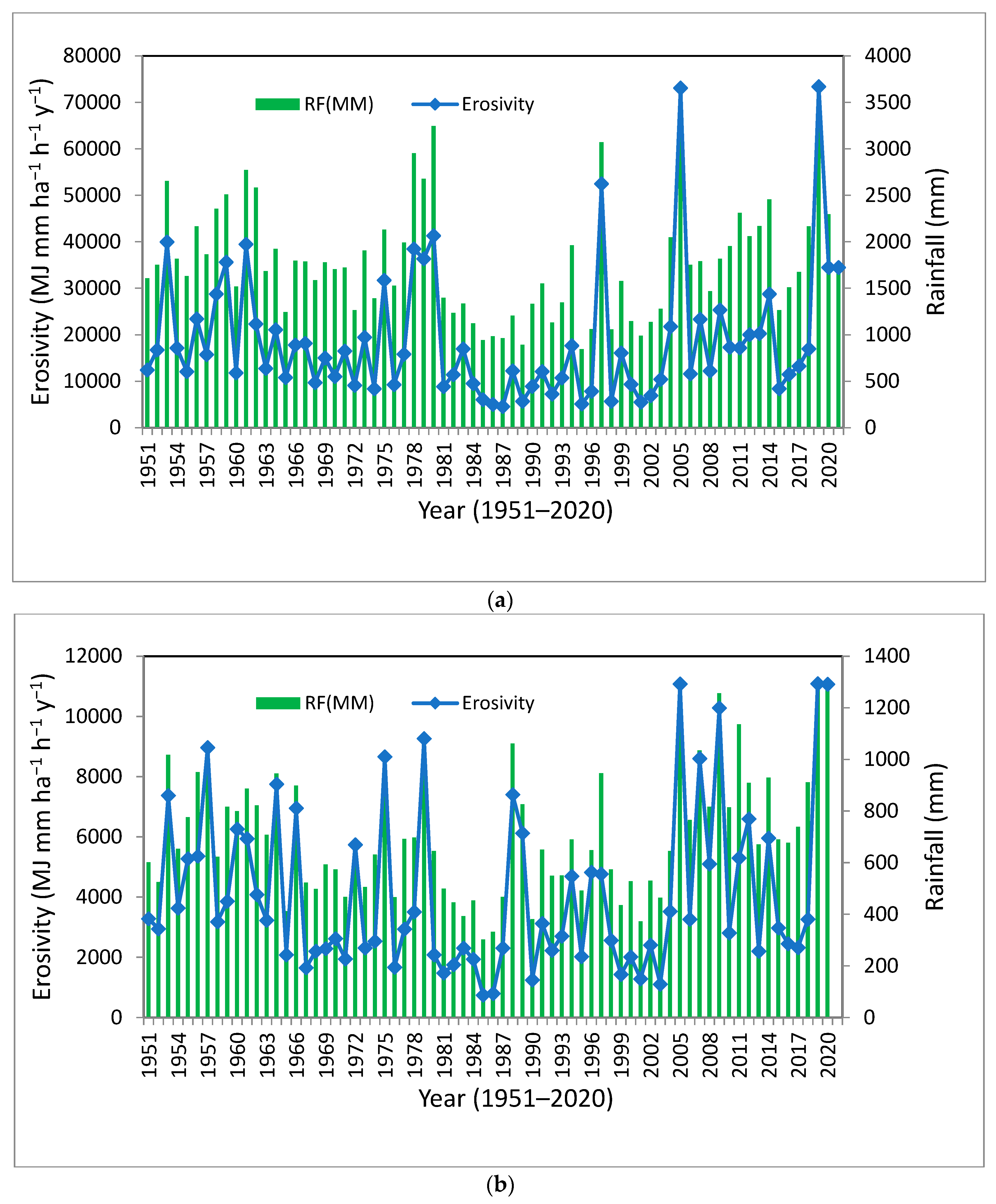
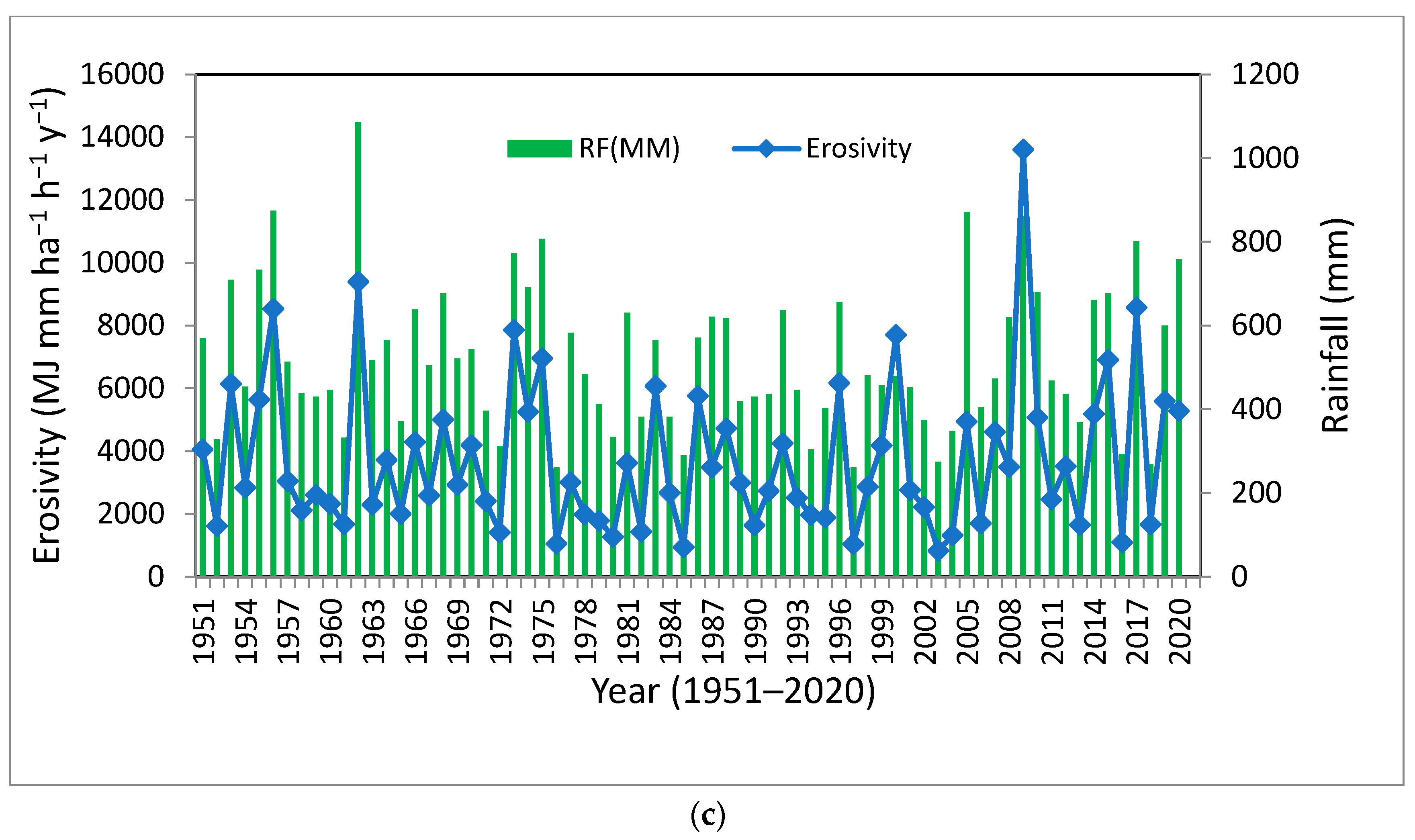
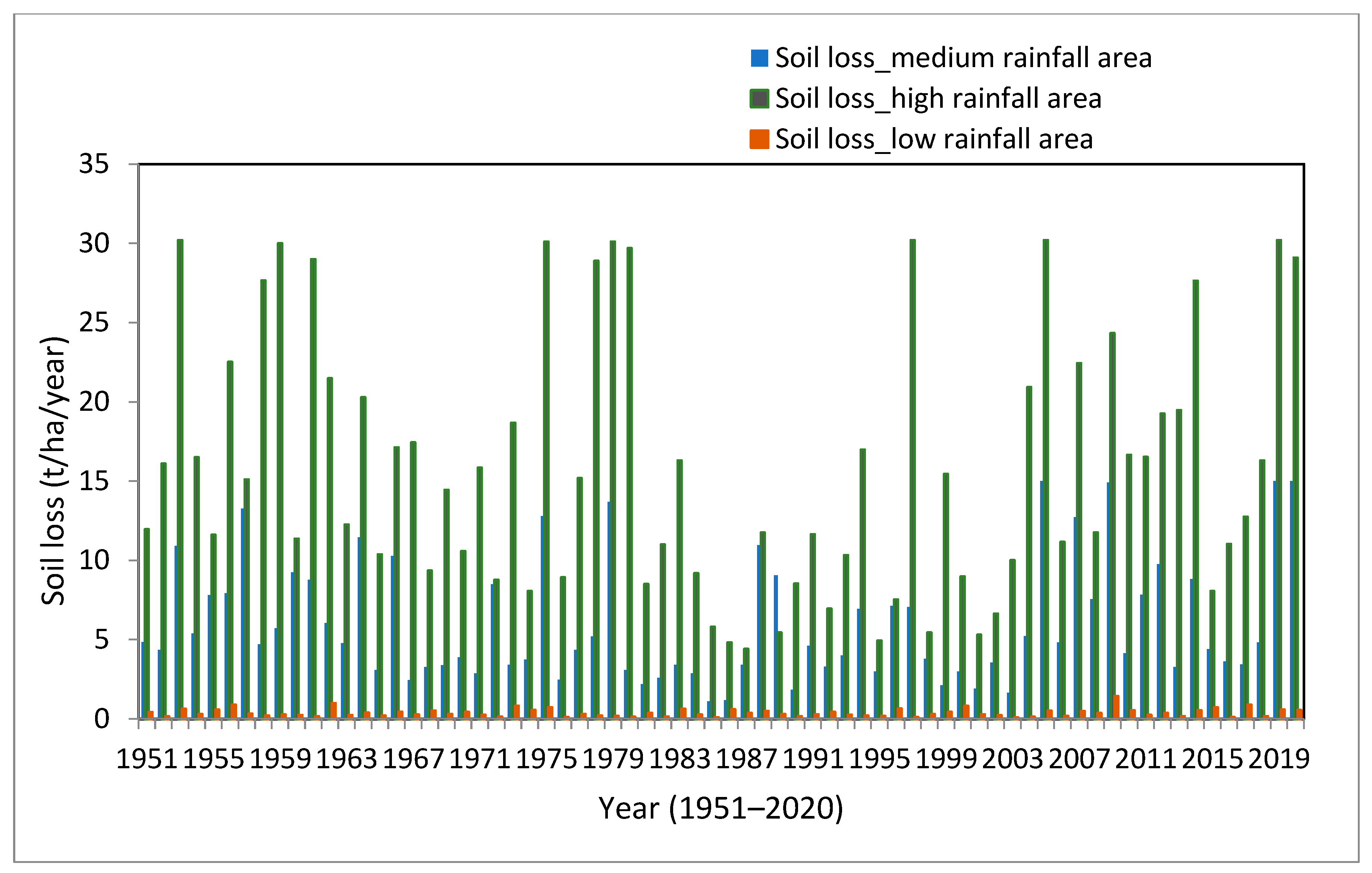
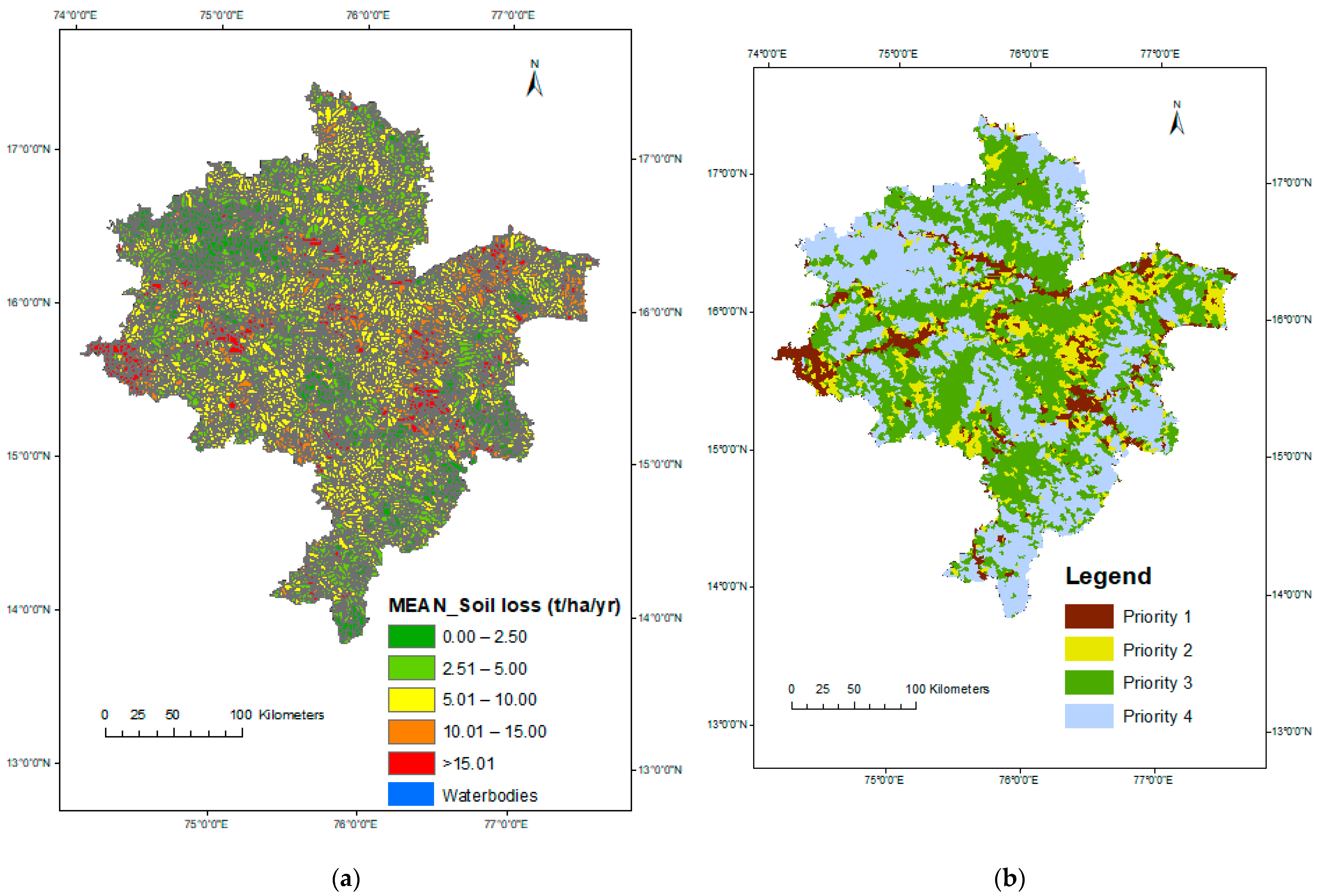

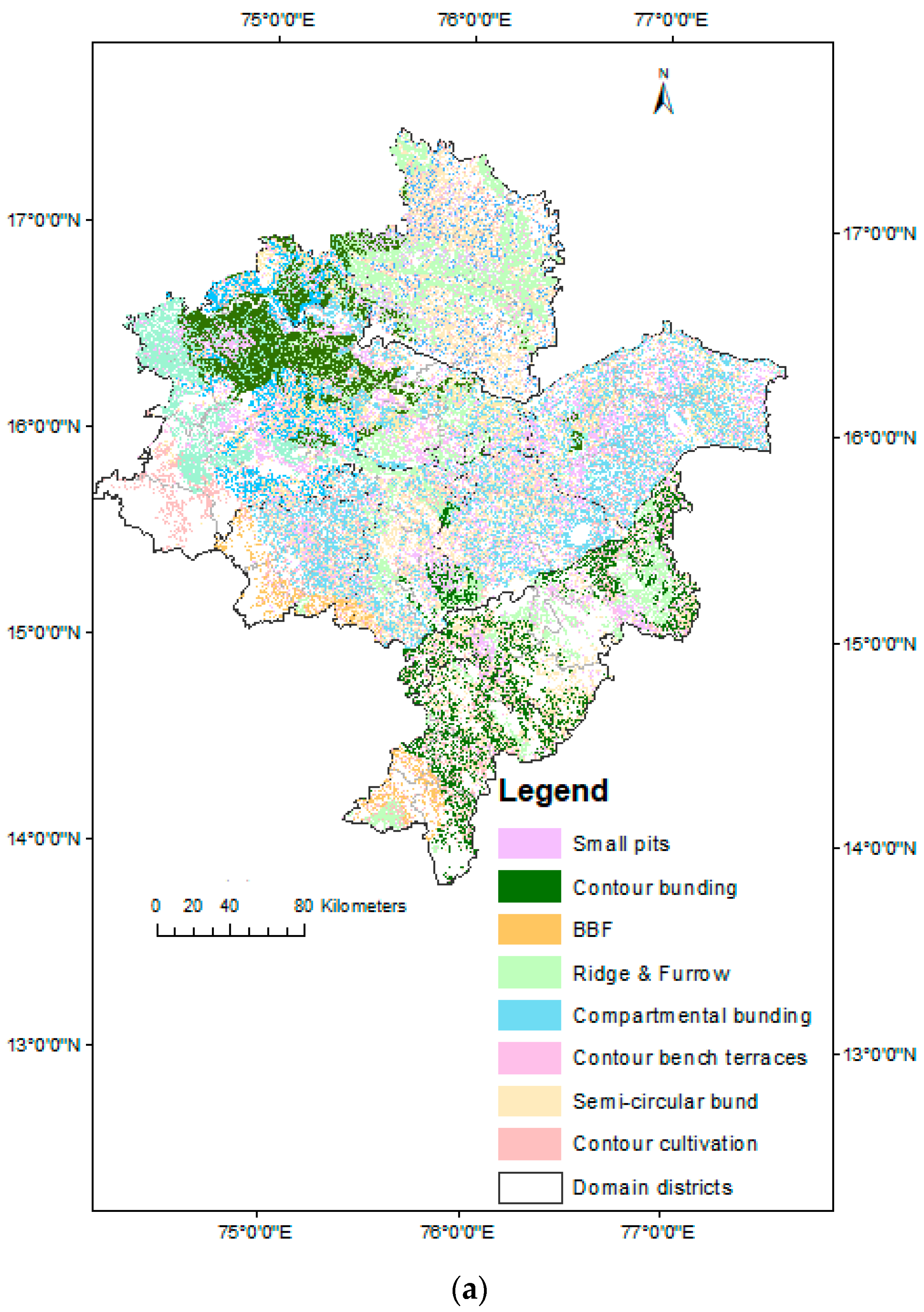
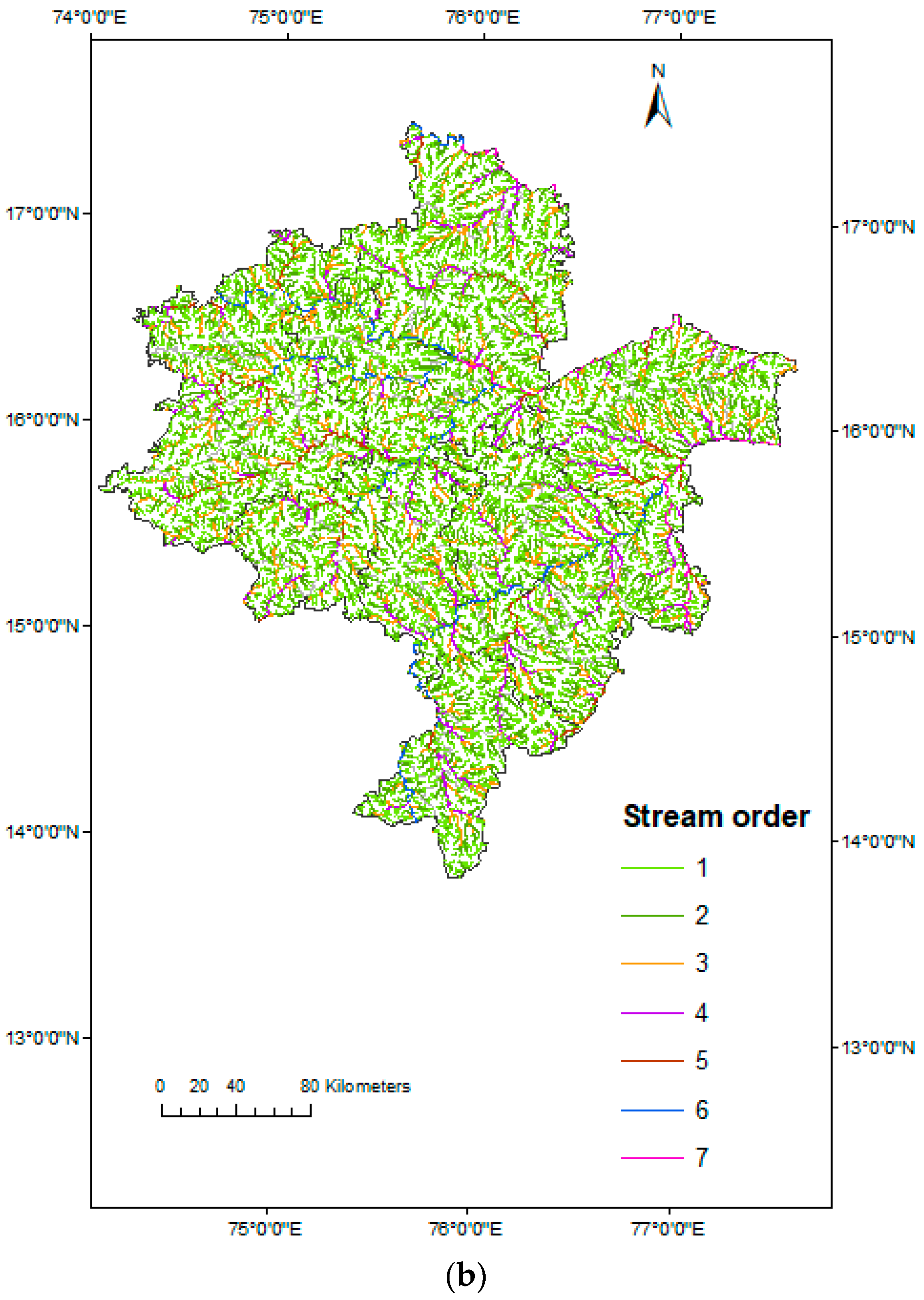
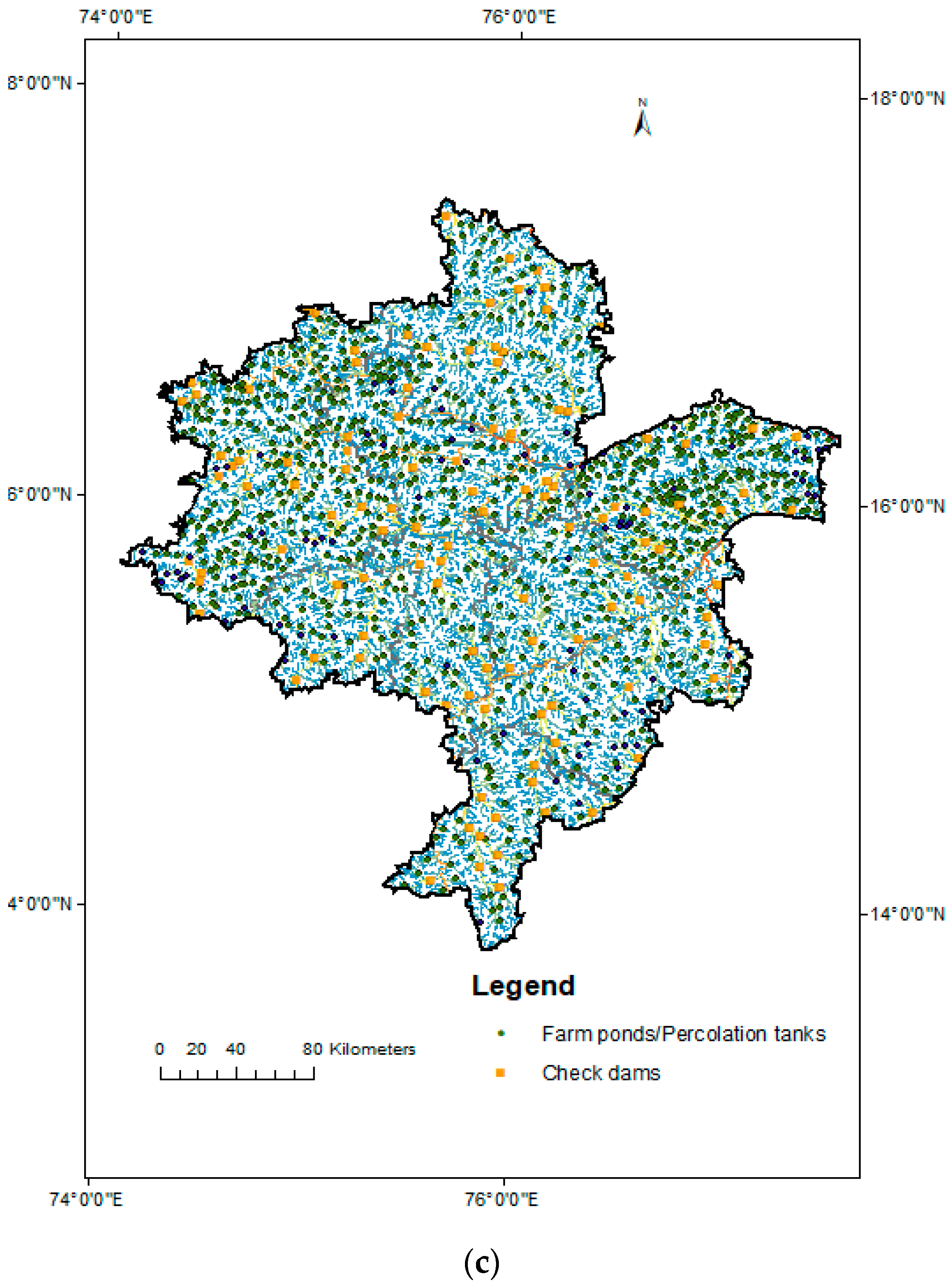
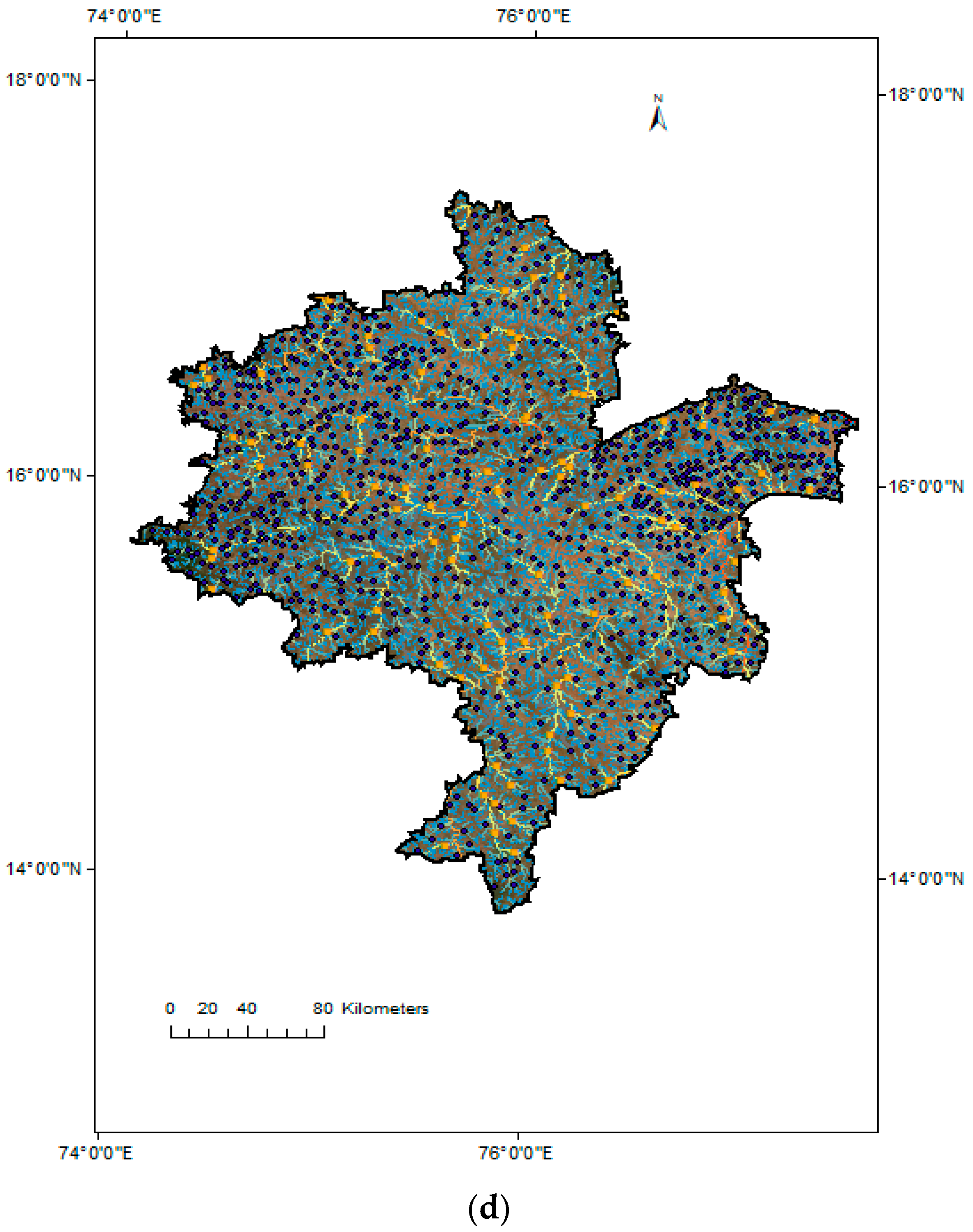
| Structure | Slope (%) | Stream Order | Catchment Area (ha) | Annual Rainfall (mm) |
|---|---|---|---|---|
| Farm ponds (lined/unlined) | ≤5 | 1–2 and other potential area | >1–2 | >500 |
| Check dams | ≤15 | 3–4 | 25 | >700 |
| Percolation tanks (Light sandy soil) | ≤10 | 1–4 | 25–40 | >700 |
| Erosion Category | Area under Each Category (ha) | % Area under Each Category | Rate of Soil Loss (t ha−1 y−1) |
|---|---|---|---|
| Low erosion | 783,537 | 11.62 | ≤2.5 |
| Slight erosion | 1,851,847 | 27.47 | 2.51 to 5.0 |
| Moderate erosion | 2,880,111 | 42.72 | 5.01 to 10.0 |
| High erosion | 707,434 | 10.49 | 10.01 to 15.0 |
| Very high erosion | 212,607 | 3.15 | 15.01 to 20.0 |
| Severe erosion | 306,089 | 4.54 | >20.01 |
| Parameters | Low-Rainfall Region | Medium-Rainfall Region | High-Rainfall Region | ||||||
|---|---|---|---|---|---|---|---|---|---|
| Drought Year | Normal Year | Above Normal Year | Drought Year | Normal Year | Above Normal Year | Drought Year | Normal Year | Above Normal Year | |
| % of Years (1951 to 2020) | 31 | 39 | 30 | 36 | 37 | 27 | 33 | 41 | 26 |
| Mean annual rainfall (mm) | 260 to 419 | 430 to 618 | 619 to 1085 | 302 to 574 | 594 to 826 | 886 to 1288 | 846 to 1397 | 1469 to 2060 | 2131 to 3505 |
| Mean erosivity (MJ mm ha−1 h−1 year−1) | 1047 to 2993 | 2608 to 4734 | 3504 to 9396 | 746 to 2563 | 2290 to 6122 | 3267 to 11,090 | 5147 to 8860 | 9290 to 25,327 | 16,698 to 73,407 |
| Mean annual soil loss (t ha−1 year−1) | 0.1 to 0.32 | 0.3 to 0.5 | 0.37 to 0.99 | 1.1 to 3.78 | 3.4 to 6.5 | 6.0 to 11.2 | 4.9 to 8.5 | 8.0 to 15.0 | 16.3 to 30.2 |
| Districts | District Area | Suitable Area (% of District Area) for Different In Situ Interventions | |||||||
|---|---|---|---|---|---|---|---|---|---|
| Small Pits | Adjusted Contour/Graded Bunds | Ridge and Furrow | Compartmental Bunding | Contour Cultivation | Semi-Circular Bunds | Conservation Furrow | Broad Bed Furrow (BBF) | ||
| Belgavi | 1,340,860.8 | 6.1 | 15.5 | 25.2 | 10.9 | 19.1 | 10.2 | 35.2 | 6.1 |
| Davengere | 595,480.6 | 1.8 | 2.2 | 4.2 | 19.8 | 35.9 | 8.9 | 61.2 | 5.2 |
| Bellary | 845,086.3 | 6.8 | 7.9 | 10.3 | 18.7 | 17.3 | 14.6 | 43.8 | 0.0 |
| Vijayapura | 1,052,237.9 | 4.6 | 3.1 | 8.6 | 8.6 | 16.3 | 31.7 | 47.4 | 24.8 |
| Raichur | 845,494.5 | 14.2 | 0.6 | 1.6 | 26.4 | 33.6 | 13.0 | 61.6 | 0.0 |
| Koppal | 557,498.7 | 13.8 | 3.5 | 5.6 | 22.9 | 24.0 | 22.0 | 55.6 | 0.0 |
| Dharwad | 428,481.3 | 5.1 | 0.0 | 1.4 | 22.7 | 40.1 | 11.0 | 76.5 | 8.2 |
| Gadag | 465,183.0 | 7.7 | 3.6 | 10.5 | 19.2 | 30.3 | 25.3 | 51.1 | 1.3 |
| Bagalkot | 658,136.8 | 9.0 | 18.6 | 24.8 | 14.2 | 19.6 | 15.8 | 36.0 | 0.0 |
| Total | 678,8459.8 | 7.5 | 7.1 | 11.8 | 16.8 | 24.3 | 16.9 | 49.2 | 6.1 |
| SI.No. | Name of the Village | Latitude | Longitude | Soil and Water Conservation Interventions Implemented |
|---|---|---|---|---|
| 1. | Vijayapura | 16° 49′ | 75° 43′ | In situ moisture conservation measures (compartment bunds, BBF, ridges and furrows, contour and graded bunds), farm ponds and percolation tanks |
| 2. | Kavalagi, Vijayapura | 16° 48′ | 75° 45′ | In situ moisture conservation measures (compartment bunds, BBF, ridges and furrows), farm ponds |
| 3. | Honnutagi, Vijayapura | 16° 45′ | 75° 50′ | In situ conservation measures (compartment bunds, BBF, furrows and ridges, graded bunds), farm ponds |
| 4. | Hegdyal, Vijayapura | 16° 44′ | 75° 49′ | In situ moisture conservation measures (compartment bunds, BBF, ridges and furrows), farm ponds |
| 5. | Honwad, Vijayapura | 16° 48′ | 75° 25′ | In situ moisture conservation measures (compartment bunds, BBF, ridges and furrows, graded bunds), farm ponds |
| 6. | Hullur, Gadag | 15° 44′ | 75° 40′ | In situ moisture conservation measures (compartment bunds, BBF, ridges and furrows, graded bunds), farm ponds |
Publisher’s Note: MDPI stays neutral with regard to jurisdictional claims in published maps and institutional affiliations. |
© 2022 by the authors. Licensee MDPI, Basel, Switzerland. This article is an open access article distributed under the terms and conditions of the Creative Commons Attribution (CC BY) license (https://creativecommons.org/licenses/by/4.0/).
Share and Cite
Rejani, R.; Rao, K.V.; Shirahatti, M.S.; Reddy, K.S.; Chary, G.R.; Gopinath, K.A.; Osman, M.; Prabhakar, M.; Singh, V.K. Spatial Estimation of Soil Loss and Planning of Suitable Soil and Water Conservation Interventions for Environmental Sustainability in Northern Karnataka in India Using Geospatial Techniques. Water 2022, 14, 3623. https://doi.org/10.3390/w14223623
Rejani R, Rao KV, Shirahatti MS, Reddy KS, Chary GR, Gopinath KA, Osman M, Prabhakar M, Singh VK. Spatial Estimation of Soil Loss and Planning of Suitable Soil and Water Conservation Interventions for Environmental Sustainability in Northern Karnataka in India Using Geospatial Techniques. Water. 2022; 14(22):3623. https://doi.org/10.3390/w14223623
Chicago/Turabian StyleRejani, Raghavan, Kondru Venkateswara Rao, Maheshwar Shivashankar Shirahatti, Kotha Sammi Reddy, Gajjala Ravindra Chary, Kodigal A. Gopinath, Mohammed Osman, Mathyam Prabhakar, and Vinod Kumar Singh. 2022. "Spatial Estimation of Soil Loss and Planning of Suitable Soil and Water Conservation Interventions for Environmental Sustainability in Northern Karnataka in India Using Geospatial Techniques" Water 14, no. 22: 3623. https://doi.org/10.3390/w14223623
APA StyleRejani, R., Rao, K. V., Shirahatti, M. S., Reddy, K. S., Chary, G. R., Gopinath, K. A., Osman, M., Prabhakar, M., & Singh, V. K. (2022). Spatial Estimation of Soil Loss and Planning of Suitable Soil and Water Conservation Interventions for Environmental Sustainability in Northern Karnataka in India Using Geospatial Techniques. Water, 14(22), 3623. https://doi.org/10.3390/w14223623






